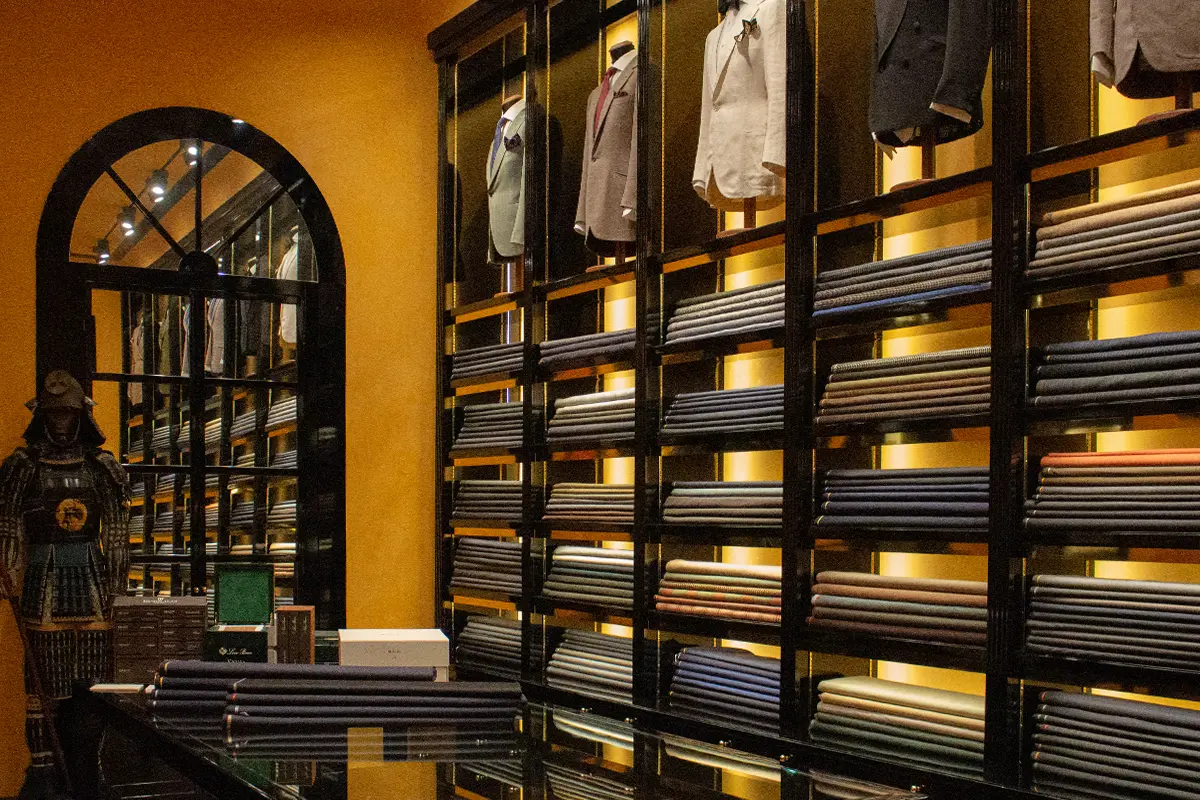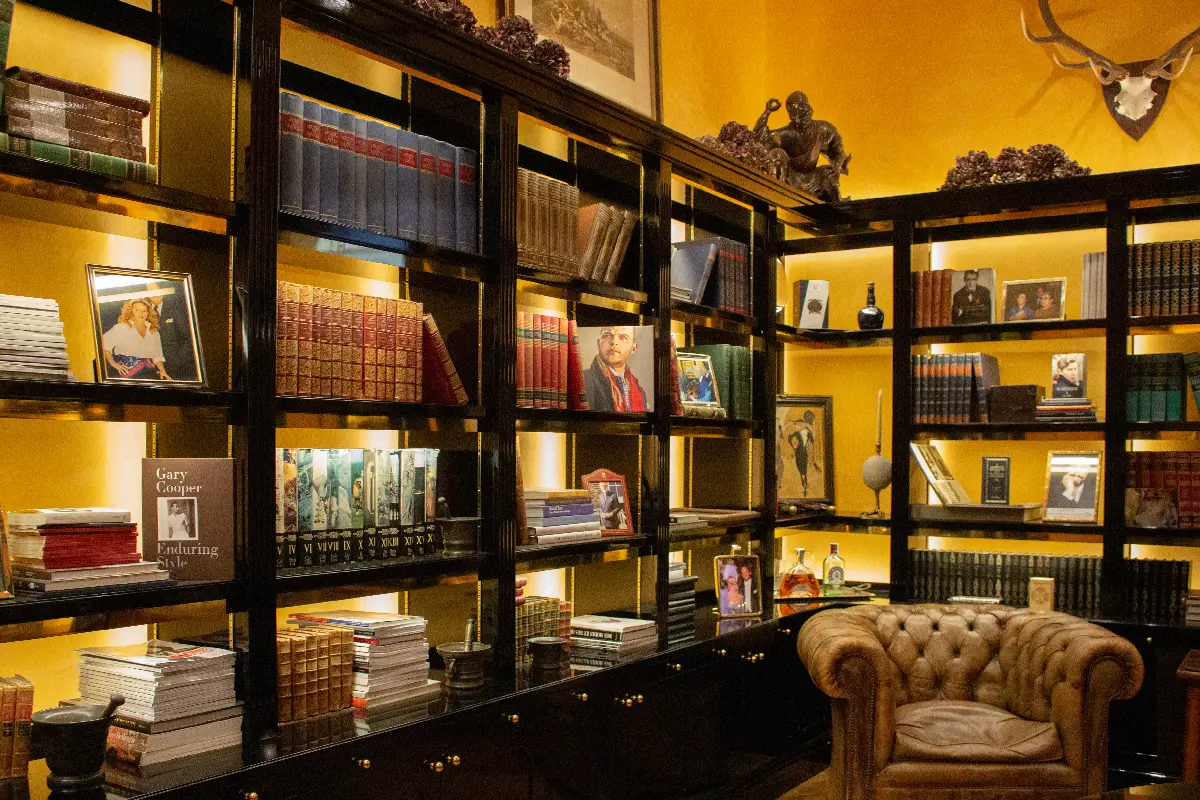Rubinacci follows a responsible approach since the 1930s. «Artisans work with fine raw materials, such as pure virgin wool, cashmere or linen: they don’t waste anything»
Born to dress Neapolitan Aristocracy – Rubinacci
Founded in 1932 with the name London House, Rubinacci was born to dress Neapolitan Aristocracy as a hobby of its founder, Gennaro Rubinacci. Considered arbiter elegantiarum, he was asked for advice on cutting or fabrics to choose from and decided – as a hobby – to set up his workshop under the name of London House.
The peculiarity of London House, now Rubinacci, was the Neapolitan Style: jackets with light, hollow shoulders and without padding; a jacket, as Luca Rubinacci, Creative Director and grandson of Gennaro, explains, «so light and soft that it could be folded up to eight times». A fitting that is very different from the classical English Saville Row Style, built on the ideal of shape given by padding, layers, and wadding used to create the perfect silhouette.
This decision was due to Rubinacci’s first customers’ needs: Neapolitan nobility wanted a relaxed fitting, not a rigorous business attire. «My grandfather,» recalls Luca, «wasn’t a tailor; that’s why he could see clothes with a critic’s eye, to favor customers and meet their needs and wishes».
Upcycling, circularity: the fine tailoring approach
Regarding circularity and sustainability, Rubinacci’s approach has made it a requirement since the beginning. «When it comes to tailoring, we talk about noble craftsmanship: sustainability has always been part of our DNA, even involuntarily» explains Luca Rubinacci. «Artisans work with fine, precious raw materials, such as pure virgin wool, cashmere or linen: they don’t waste anything, and with the minimum, they need to obtain the maximum result».
When asked about an example of circularity for bespoke clothing, Luca Rubinacci showcases details on his jacket’s sleeve: the last buttonhole is not open but sewn.
«This detail makes it possible to pass the apparel to the next generation. Usually, men’s bespoke clothes pass to their sons. If the son is shorter or the same size, there’s no problem. But if the son is taller, this trick can help fix the sleeve, making a jacket last longer and fit more than one customer».
Passing down to the next generations
Rubinacci suits are not made to last one season; neither one generation. But it is made to pass down to the next generations. In the past, the life of a suit didn’t stop with sons, as Luca Rubinacci explains.
Between 2005 and 2008, he embarked on the project to find and collect clothes his grandfather had sold in the 1930s. «With the help of Count Leonetti of Naples, we found suits belonging to Curzio Malaparte, Totò, De Sica, of the Prince of Piedmont». When they found vintage Rubinacci tights and suits, Luca noticed they had colored stitched patches.
This is because after passing down to the sons, the suits’ life continued, passing down to servants and chauffeurs, and when they weren’t usable anymore, there were transformed into clown clothing to make children laugh. «Nowadays, those clothes are displayed in Victoria and Albert Museum in London – I wanted to take the patches off, but my father made me notice they are part of Rubinacci’s history. And he was right,» Luca Rubinacci recalls.
Rubinacci bespoke suits
One of its core businesses of Rubinacci is indeed bespoke suit making: «Our production capacity is hovering around 700 suits worldwide, as we are in a very specific market niche,» explains Luca Rubinacci, talking about the post-pandemic market for business attire. «Even if after Covid we assisted in a boom of our ready-made clothing, we still achieved our maximum production capacity, and around May or June, we have to close bespoke orders for six months, and again in December or January».
The bespoke experience also focuses on customers’ needs: building a custom wardrobe and expressing their personality and style through clothing. «The ready-to-wear follows more the trends of the moment while still keeping a classical fitting, and the customer needs to find his size in a precise range. But our bespoke approach is completely different».
It is key to make the suits last for generations
And Luca Rubinacci continues: «In the made-to-measure, there are no trends: we satisfy customers, letting them create their style but without renouncing Rubinacci’s DNA. We create a wardrobe made to last: our suits don’t even show our brand, but just the customer’s name written inside a pocket, with the date and a serial number».
And this serial number is key to make the suits last for generations: in fact, it goes back to the specific fabric used to make the suit, stored in their archive. «This way,» explains Luca Rubinacci, «we can provide alterations and repairs; if the fabric rips off or the customer changes his size, we can fix it. Of course, it must be the same color bath used to make the suit, so we usually keep 30/40 cm of fabric for every suit we make. If we don’t need them anymore, we recycle them, making different products such as wallets, boxers, and so on».
The Vintage Archive and fabrics
Regarding fabrics, Rubinacci now stores more than sixty-thousands meters of textiles, some of them more than sixty years. «Until the Seventies, Rubinacci used to buy bales of cloth, since a tailoring house, to be perceived as prestigious, needed to offer a wide choice to its customers» he states.
And continues, «we stored all these textiles in a cave, preserving cloth from humidity for decades, and we never tried to sell them in markets. And then, during Covid lockdowns, the Vintage Archive was born. We wanted to satisfy our customers, but the fabric suppliers were still closed; till then, the vintage textiles were used for bespoke suits only, but we decided to try it» he explains.
Creating made-to-order pieces
«Instead of ordering and producing new fabrics, we use our archive for ready-made apparel too. Of course, pieces are very limited, and we cannot offer all sizes since we only focus on our best sellers. Plus, we also give the opportunity to create made-to-order pieces, choosing from different fabrics» Luca Rubinacci concludes.
For these ready-made unique pieces, made with vintage fabrics, Rubinacci set a fair price: «we don’t want to raise our prices because the fabric is vintage, and it has already been amortized so that we can offer high-quality fabrics at a reasonable price».
When it comes to fabrics, Rubinacci mainly focuses on natural ones, such as linen, wool, and flannel: «we don’t necessarily focus on Made in Italy, but on finding the best quality for our customers. For example, when we need to buy linen, we rely on Irish ones for winter since their line wrinkle less. For summer clothing, we use the Italian one, more soft and light».
Modern tailoring and sustainability
Now at the third generation, Rubinacci focuses even more on sustainability, not only with long-lasting suits and responsible sources management; «in the upcoming years, we will open new 4.0 laboratories right outside Naples, and we will also look for more sustainable dyes since as of today it’s hard to find environmentally-conscious dyes, especially for winter collections that need darker colors» explains Luca Rubinacci.
«We don’t widely talk about our sustainable politics, but the packaging, is all made from FSC-certified cardboard, while our signature ribbons and bags are being changed to recyclable materials. We are also eliminating paper receipts and moving to email receipts. Plus, since our eCommerce is a huge part of the business, we opt for optimized transport routes, alternative vehicles, or energy-efficient warehouses in partnership with DHL».
When asked why they don’t widely tackle sustainability topics, Luca Rubinacci explains: «craftsmanship and fine tailoring is already sustainable per se; from this point of view, we’ve always been sustainable, encouraging circularity and upcycling».
Rubinacci ‘salotto’ in the heart of Milan
Rubinacci boutique in Via del Gesù, Milan, opened in 2015 and has been designed as a gents club, a salotto where to discuss sartorial culture.
And indeed, special attention has been dedicated to the bespoke atelier, in the back of the boutique, right behind the rooms dedicated to ready-made collections. Here, as Luca Rubinacci points out, the setting has been designed as a lounge more than as a fitting room. «We want our customers to feel comfortable, at ease, and that cannot happen in a small dressing room full of mirrors».
The bespoke atelier
The room, as the whole boutique, has a warm atmosphere, with polished hardwood floors, vases with hydrangeas, and dark shelves with ready-made clothes, cloth samples, and types of shirt collars on full display. Downstairs, passing by one of the historical suits made by Gennaro Rubinacci in the 1930s, the fabrics archive: in a small room, where humidity and temperature are under constant control, meters of vintage cloth are stacked and piled up.
From the beginning of its journey, Rubinacci perpetuated a vision of Neapolitan style with stores and boutiques in Milan, Naples, London, Tokyo, New York, Singapore, and many other cities. Now the third generation, with Luca Rubinacci, is reinventing itself, transporting the concept of traditional tailoring in modern days, with an eye on new customers’ needs and sustainability. «At Rubinacci, we follow the three rules of luxury: aesthetic, product quality, and innovation. This last one, with a special focus on sustainability, both environmental and social».
Rubinacci
An Italian luxury clothing company founded in Naples, Italy in 1932 by Gennaro Rubinacci under the name of the London House. The idea Rubinacci had was to create unstructured, unlined jackets meant to be worn outside of the office. As of 2018, Luca Rubinacci, Gennaro’s grandson, is the creative director of Rubinacci, and responsible for launching the firm’s ready-to-wear line.




















